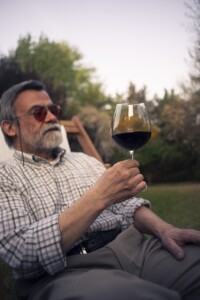To see imagery as mere ornament in a story is like seeing a man’s head as just a pedestal for his bonnet.
—William Shakespeare
Hey, I said that.
—Francis Bacon
So when did men start wearing bonnets?
—Emmeline Pankhurst
What kind of a name is “Emmeline”? And what’s a bonnet?
—Lady Gaga
There are two basic sources of vividness in language: newness and contrast. Newness, as we have already noted, is limited by our need to use words that mean something, hence are known and therefore dull. But if you can’t go very far using new words, you can go wild putting the old words into new contexts.
This is what imagery is all about. Far from being a mere ornament, imagery is a life-support system for the attention of a reader. The best writers, however, put imagery and contrast together, so that a notably static and ordinary situation is likely to be described with exotic imagery. That is, the lively imagery is chosen to contrast with the boring material.
If your nerves will take it, consider this passage from Dickens:
It was a town of red brick, or of brick that would have been red if the smoke and ashes had allowed it; but as matters stood it was a town of unnatural red and black like the painted face of a savage. It was a town of machinery and tall chimneys, out of which interminable serpents of smoke trailed themselves for ever and ever, and never got uncoiled. It had a black canal in it, and a river that ran purple with ill-smelling dye, and vast piles of building full of windows where there was a rattling and a trembling all day long, and where the piston of the steam-engine worked monotonously up and down, like the head of an elephant in a state of melancholy madness. It contained several large streets all very like one another, and many small streets still more like one another, inhabited by people equally like one another, who all went in and out at the same hours, with the same sound upon the same pavements, to do the same work, and to whom every day was the same as yesterday and to-morrow, and every year the counterpart of the last and the next.
Hard Times
It is important to note that Dickens is describing a town that is intensely and violently—monotonous! His imagery is chosen to contrast with its subject, so that the dead and boring town is characterized by images that leap about madly, suggesting a violent and throbbing life. “The painted face of a savage. “Interminable serpents of smoke.” “An elephant in a state of melancholy madness.”
Dickens makes his dull, uniform town look charged with energy and downright spooky, since he can’t very well show tedium with tedious rhetoric, even if it might seem appropriate. As a general rule, any time you describe something the reader already knows, you need to use a description chosen precisely for its newness. And if you want it to be memorable, then you have to put action and the exotic into your description.
Here is Dickens bringing table furnishings to life:
Everything said boastfully, ‘Here you have as much of me in my ugliness as if I were only lead; but I am so many ounces of precious metal worth so much an ounce;—wouldn’t you like to melt me down?’ A corpulent straddling epergne, blotched all over as if it had broken out in an eruption rather than been ornamented, delivered this address from an unsightly silver platform in the centre of the table. Four silver wine-coolers, each furnished with four staring heads, each head obtrusively carrying a big silver ring in each of its ears, conveyed the sentiment up and down the table, and handed it on to the pot-bellied silver salt-cellars. All the big silver spoons and forks widened the mouths of the company expressly for the purpose of thrusting the sentiment down their throats with every morsel they ate.
Dickens, Our Mutual Friend
And here is another example:
Some attempts had been made, I noticed, to infuse new blood into this dwindling frame, by repairing the costly old wood-work here and there with common deal; but it was like the marriage of a reduced old noble to a plebeian pauper, and each party to the ill-assorted union shrunk away from the other.
Dickens, David Copperfield
Here again Dickens puts life into his writing by scattering living things among his images: new blood, a reduced old noble, a plebeian pauper—all this to suggest the failed attempt to repair a nice hardwood with fir or pine. The differential shrinking, owing to the different qualities of the two woods, is given life by its connection to social differences. The alternative, of course, is to do a straightforward description of objects the reader is familiar with that are made out of dead wood. And it should be noted that here, as always, Dickens’ pages are littered with violations of the Word-Parsimony theory. This is because the introduction of newness and action and contrast into a description typically lengthens it rather than shortening it.
We see this in the following passage from Mark Twain, the substance of which is that the floor of a room is covered with an old carpet with figures in colors that clash:
The floor of the room is covered with a superannuated nightmare of a carpet whose figures are vast and riotous, and whose indignant reds and blacks and yellows quarrel day and night and refuse to be reconciled.
Twain, “Villa di Quarto”
Here we see the abject failure of both the word-parsimony theory and the “exact word” theory. “Superannuated” is not only much longer than “old” but is used “improperly” here, since it normally refers to people put into retirement, not furnishings. But this very fact (along with its uncommonness) makes it unexpected, hence vivid. In addition, it has the marked advantage of referring to something typically alive, even if barely, rather than dead. And then Twain takes a dead metaphor (“colors that clash”) literally and expands it into a kind of Civil War among three factions. The assumption that there are forces trying to reconcile the clashing colors is a nice touch.
Books on style routinely tell us not to use old, used-up metaphors. Actually, good writers do this all the time—it’s just that they renew them by pretending to take them literally, as Twain does here. S. J. Perelman is especially good at this. Here he revisits the ancient notion of weaving as a metaphor for the creation of a story:
“With the aid of a small hand loom, I have woven a few necessary elements into an action-packed, down-to-earth yarn…”
Perelman, “Chewies the Goat but Flicks need Hypo”
We probably shouldn’t move on without translating Perelman’s title. When we came across it, our first guess was that “Chewies” was the name of a goat, but then it can’t be followed by a conjunction. Once we read the essay, we were able to provide a glossary:
Chewies: the food available in the lobby of a theater
Goat: scapegoat
Flicks: movies (short for “flicker,” which movies once did)
Hypo: stimulus.
You might wonder why a brilliant writer would be obscure, but the problem is that humor depends on vividness, and vividness depends on newness, so Perelman is in the habit of routinely turning every phrase into something hitherto unknown. The only word here that he actually made up is “chewies,” and he probably pondered a few other possibilities before he chose it.
If they ever put on a clumsy-title derby, Perelman’s will be the odds-on favorite. And yes, it is kind of fun for an average writer to offer criticisms of a brilliant one. But if Perelman were here, he would end all criticism by suggesting that we come up with something better. And no, we’re not going to try.
Here is Dickens taking on the challenge of making fog vivid:
Fog everywhere. Fog up the river, where it flows among green aits and meadows; fog down the river, where it rolls defiled among the tiers of shipping, and the waterside pollutions of a great (and dirty) city. Fog on the Essex marshes, fog on the Kentish heights. Fog creeping into the cabooses of collier-brigs; fog lying out on the yards, and hovering in the rigging of great ships; fog drooping on the gunwales of barges and small boats. Fog in the eyes and throats of ancient Greenwich pensioners, wheezing by the firesides of their wards; fog in the stem and bowl of the afternoon pipe of the wrathful skipper, down in his close cabin; fog cruelly pinching the toes and fingers of his shivering little ’prentice boy on deck. Chance people on the bridges peeping over the parapets into a nether sky of fog, with fog all round them, as if they were up in a balloon, and hanging in the misty clouds.
Bleak House
Most of us would find this is a difficult challenge. Fog, after all, lacks color, volition, and lively movement. But Dickens knows that if it is to hold the attention of his reader, his fog cannot by any means be allowed to remain fog-like. So while other people’s fog pretty much stays in one place, or at best creeps about on little cat feet, Dickens’ fog flows, rolls, creeps, lies, hovers, droops, and even pinches the toes of an apprentice.
And note all the ways in which Dickens has introduced contrast: green meadows/waterside pollution; marshes/heights; great ships/small boats; cabooses of collier-brigs/rigging of great ships. The collier-brigs remind us that competent writers of fiction choose their words according to how vivid they are, and vividness is in inverse proportion to commonness. So Dickens will generally give you specific terms whether or not they are likely to be familiar. Most English-speakers probably don’t know what an “ait” is (an island in a river), just as Germans can’t be counted on to be familiar with its German equivalent (“Werder”). The terms are rare because they’re in competition with “island”/“Insel,” but their rarity make them lively words even if they may be unfamiliar ones. And you probably don’t know that a caboose was a small galley or cookhouse on the deck of a small vessel—that usage of the term has pretty much disappeared. From Dickens’ point of view, however, its rarity makes it a better choice than “galley.”
Remarkably, Dickens brings his passage to life virtually without imagery. We don’t happen to be great fans of his, but there are few writers with a more profound understanding of how to make language vivid. Still, this isn’t that hard to learn if you concentrate rigorously on a couple of rules:
Your sentences should be previously unknown to the world.
Most description should rely heavily on imagery, and if the subject itself isn’t alive and exotic, then the imagery should be. The most exact and literal description of a carpet can’t compare with Twain’s civil war of colors and figures.
Originally published in another dementia on August 21, 2011

